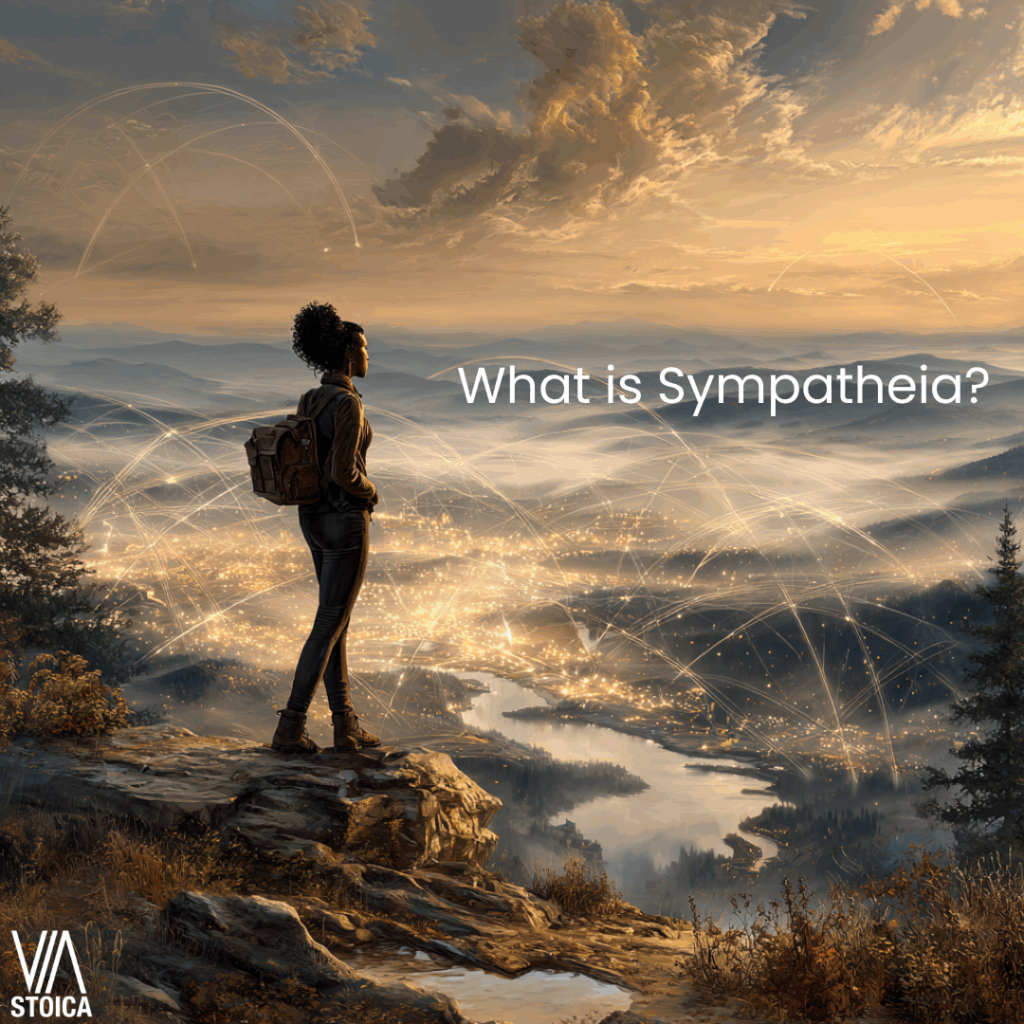What is Sympatheia?

Sympatheia (συμπάθεια) in Stoicism reminds us of the deep interconnectedness of all things in the universe. It is the understanding that every person, being, event, and action is part of a larger, rational whole (Logos), and that we each have a role to play within it.
More than a feeling or attitude, Sympatheia is a perspective shift. It calls you to zoom out and see the bigger picture: that every human being, every creature, every star is participating in the same vast and ordered cosmos. To live with Sympatheia is to align yourself with that whole, to act with harmony, humility, and care. The Stoics were among the first to call themselves true cosmopolitans.
Let’s unpack this essential Stoic term and explore how it can transform how you see the world and live your life.
Breaking Down the Word
Sympatheia (Greek: συμπάθεια) is composed of two parts:
- σύν (syn) – meaning together or with
- πάθος (pathos) – meaning feeling or experience
Literally, it translates to feeling together or shared experience. But in Stoic philosophy, this goes far beyond shared emotion. Sympatheia refers to a metaphysical and moral truth: everything in the universe is part of a living, rational whole. Nothing exists in isolation.
Marcus Aurelius reminds himself:
“You should meditate often on the connection of all things in the universe and their relationship to each other.”
Marcus Aurelius, Meditations, Book 6.38
These aren’t just beautiful words. For the Stoics, Sympatheia is a natural consequence of Logos, the rational principle organizing the cosmos. Everything participates in this cosmic reason, including you.
Key Dimensions of Sympatheia
- Cosmic Interconnection
You are not a separate entity. You are a thread in the fabric of the universe. Your actions ripple outward. - Moral Kinship
All rational beings, especially humans, are part of the same moral community. To harm another is to harm yourself. - Perspective Shift
Sympatheia helps you zoom out and view problems, desires, and judgments from a wider lens. This fosters resilience, humility, and compassion. - Natural Belonging
Living “according to nature” includes living according to shared nature. Your purpose is tied to the whole.
Core Stoic Principles and Sympatheia
- Virtue (ἀρετή)
Practicing justice, kindness, and courage isn’t just about you; it’s your duty as part of the greater whole. - Reason (λόγος)
Your rationality connects you to the cosmic reason that governs everything. - Nature (φύσις)
Nature isn’t just “the outdoors”; it’s the rational, ordered system you’re embedded in. - Wisdom (σοφία)
True wisdom is understanding your place within the whole and acting accordingly. - Community (κοινωνία)
Sympatheia is the spiritual foundation of community. Without it, Stoicism becomes a self-centered practice. With it, it becomes a way to serve.
Modern Misunderstandings
Sympatheia vs Empathy
While modern empathy is often emotional resonance, Sympatheia is ontological and ethical. It’s not just feeling for others, it’s knowing you are others in a deeper sense.
Sympatheia vs Individualism
Modern culture prizes independence. Stoicism values self-discipline within interdependence. You are responsible for yourself, but never disconnected.
Why It’s Central to Stoicism
Sympatheia connects us to the guiding principle. The interconnectedness places our own actions on a larger scale and thus adds a responsibility on our shoulders to do the right thing. Marcus Aurelius reminds us again and again: every moment is an opportunity to return to our shared nature and act accordingly.
In Meditations, he writes:
“What injures the hive injures the bee.”
Marcus Aurelius, Meditations, 6.54
This quote is not a metaphor; it’s a moral truth. Sympatheia guides Stoic cosmopolitanism, compassion, and moral duty. It’s the soul of Stoic action.
How to Practice Sympatheia
- Morning Reflection
Start your day by reminding yourself: I am part of the whole. My choices affect the cosmos, however small they may seem. - Zoom Out in Conflict
When someone irritates you, pause. Remember: this person is your kin in the cosmos. How would you respond if you saw their whole story? - Journaling Prompt
Where did I act today with awareness of the whole? Where did I act as if I were separate? - Practice Common Humanity
When reading the news or facing disagreements, challenge yourself: What do I share with this person? How can I act in line with that shared nature?
FAQ
What does Sympatheia mean in Stoicism?
It’s the awareness of your deep connection to all of existence, cosmic, rational, and moral.
Is Sympatheia the same as empathy?
Not exactly. Empathy is emotional. Sympatheia is philosophical: it’s about living in harmony with others because you are fundamentally one with them.
Can anyone develop Sympatheia?
Yes. It starts with awareness and grows through daily reflection, action, and the practice of virtue.
Conclusion
Sympatheia is not just a Stoic concept; it’s a way of seeing. A way of being. It breaks down barriers between self and other, between duty and desire, between what happens to you and what happens through you.
To live with Sympatheia is to live with greater peace, purpose, and connection.
Start today, even in small ways. Feel the whole, and act from it.
Learn more
Want to explore more Stoic strategies? Book a free consultation with one of our Stoic Coaches or learn about more Stoic philosophy terms. You can also listen to the Via Stoica podcast on Spotify or Apple Podcasts or watch it on YouTube.



0 Comments